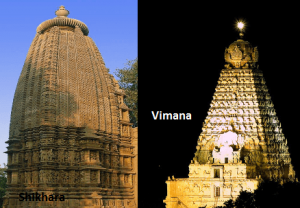Temple architecture of india
Introduction :- the temple word is derived from a Latin word templum , means a structure reserved for religious or spiritual activities such as prayer and sacrifices. It is considered that the earliest form of temple had emerged in Gupta period, since then it has been an integral part of Hindu tradition . Nowadays prayers in the temple are considered very auspicious before the beginning of any occasion and work .
The basic form of Hindu temple comprises the followings :


The basic form of Hindu temple comprises the followings :
- Garbhagriha: Literally means womb-house. It is a cave-like sanctum which houses the main icon of the temple. In earlier times, it was a small cubicle with one entrance. In later periods, it grew into a larger chamber.
- Mandapa: The entrance to the temple. It could be a portico or a collonaded hall where worshippers stand.
- Shikhara/Vimana: Noticed from the 5th century CE. It is a mountain-like spire on top. In north India, it is called Shikhara and is curving in shape. In the south, it is like a pyramidal tower and is called Vimana.

- Amalaka: Stone-like disc seen at the top of the temple. Mostly in north Indian temples.
- Kalasha: It is the topmost part of the temple. Mainly seen in north Indian styles.
- Antarala: It is a vestibule between the Garbhagriha and the Mandapa.
- Jagati: This is common in north Indian temples and is a raised platform where devotees can sit and pray.
- Vahana: It is the vehicle of the main deity which along with the standard pillar or Dhvaj which are placed axialy.
Types of Indian temple architecture
Basically there are 3 kinds of temple architecture:
- Nagara Style
- Dravida Style
- Vesara Style
Niagara style
From 5th century A.D. onwards , a distinct style of temple architecture developed in the northern region of India , known as nagara style of architecture. Even in Nagara school, different sub-schools emerged in Western, Central and Eastern parts of India
Features of it
* The temples generally followed Panchayat style of temple making , which consisted subsidiary shrines laid out in a crucified ground plan with respect to the principal shirne
* Presence of assembly halls or mandaps in front of the principal shrines
* Ganga and Yamuna images of river Goddess were placed outside the garbhariha
* There were no water tanks or reservoirs in temple premises
* Temple were generally built on raised platform
* The porticos had Pollard approach
Three sub schools developed under Nagara style:
Odisha School
- Most of the main temple sites are located in ancient Puri and Konark.
- Here the shikhara, called deul in Odisha, is vertical almost until the top when it suddenly curves sharply inwards.
- Deuls are preceded, as usual, by mandapas called jagamohana in Odisha.
- The ground plan of the main temple is square, which, in the upper reaches of its superstructure becomes circular in the crowning mastaka.
- The exterior of the temples are lavishly carved, their interiors generally quite bare.
- Odisha temples usually have boundary walls.
- Example: Konark Temple, Jagannath temple, Lingaraj temple.

Khujuraho/Chandel school
- Khajuraho’s temples are known for their extensive erotic sculptures
- Patronized by Chandela kings of Bundelkhand (10th and 11thcentury).
- These 22 temples (out of the original 85) are regarded as one of world’s greatest artistic wonders.
- The finest among them is Shaivite temple known as Kandariya Mahadev, built around 10th century by King Ganda
- The standard type of Khajuraho temple has a shrine room, an assembly hall, and an entrance portico.

- These entities were treated as a whole, whereas in the Odishan style they were conceived as separate elements.
- The sikhara is curved for its whole length, and miniature sikharas emerge from the central tower.
- The halls and porticos of the temple are also crowned with smaller towers which rise progressively upto the main tower.
- Vishnu Temple at Chaturbhunj (MP) is another prominent temples at Khajuraho.
Solanki School
- Patronized by Solanki kings (later Chalukya) of Gujarat (11th to 13thcentury).
- The Vimala, Tejpala and Vastupala temples at Mount Abu exhibit this style.
- Dilwara temple in Mt Abu – Highest Jain pilgrimage
- Exquisite example is Sun temple at Modhera, built by Raja Bhimdev-I of the Solanki Dynasty in 1026
Dravidian style of temple architecture
Under the patronage of chola rulers , hundreds of temples were built in South India , this came to be known as Dravidian style .
Features of it
* Temples in this style were surrounded by high boundary walls
* The front wall had a high entrance gateway Known as Gopuram
* The temple premises laid out in the Panchayatan style with a principal temple and four subsidiary shrines
* The assembly hall was connected with the garbhariha by a vestibullar tunnel known as antarala.
* Presence of water tank or reservoirs in temple premises was a unique feature of this style
E.g. Brihadeswara temple at tanjore ( built by raja raja 1st in 1011 A.D. ) , Ganagakondaicholapuram temple ( built by rajarajendra 1st to commemorate victory in gangatic delta
Vesara style
It's also known as Karnataka school of architecture, it flourished under the later chalukya ruler in the mid-seventh century A.D. it combined the features of both Nagara and Dravidian style.
Features of it
* This style emphasised on vimana and mandaps
* There is the presence of open ambulatory passageway around garbhariha
* The pillars doorways and the ceilings were decorated with intricate carving
E.g. Ladkhan temple at Aihole , temple at Badami




Comments
Post a Comment